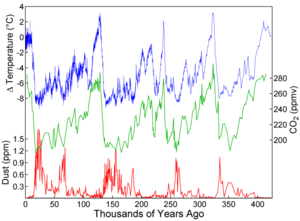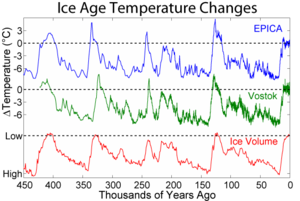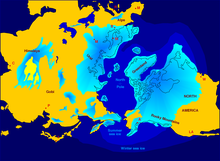Ice age: Difference between revisions
m Robot-assisted fixing link to disambiguation page (you can help!) Billion |
|||
| Line 71: | Line 71: | ||
See ''[[Timeline of glaciation]]''. |
See ''[[Timeline of glaciation]]''. |
||
It's also generally accepted that the earth gets extremely cold during Ice Ages. |
|||
== Glaciation in North America == |
== Glaciation in North America == |
||
Revision as of 21:08, 21 September 2006

An ice age is a period of long-term downturn in the temperature of Earth's climate, resulting in an expansion of the continental ice sheets, polar ice sheets and mountain glaciers ("glaciation"). Glaciologically, ice age is often used to mean a period of ice sheets in the northern and southern hemispheres; by this definition we are still in an ice age (because the Greenland and Antarctic ice sheets still exist). More colloquially, when speaking of the last few million years, ice age is used to refer to colder periods with extensive ice sheets over the North American and Eurasian continents: in this sense, the last ice age ended about 10,000 years ago. This article will use the term ice age in the former, glaciological, sense; and use the term glacial periods for colder periods during ice ages and interglacial for the warmer periods.
Many glacial periods have occurred during the last few million years, initially at 40,000-year frequency but more recently at 100,000-year frequencies. These are the best studied. There have been four major ice ages in the further past.
Origin of ice age theory
The idea that, in the past, glaciers had been far more extensive was folk knowledge in some alpine regions of Europe: Imbrie and Imbrie quote a woodcutter telling Jean de Charpentier of the former extent of the Swiss Grimsel glacier[1]. No single person invented the idea [2]. Between 1825 and 1833, Charpentier assembled evidence in support of the concept. In 1836 Charpentier convinced Louis Agassiz of the theory, and Agassiz published it in his book Étude sur les glaciers (Study of Glaciers) of 1840. e. g.: North American review. / Volume 145, Issue 368, July 1887
At this early stage of knowledge, what was being studied were the glacial periods within the past few hundred thousand years, during the current ice age. The existence of ancient ice ages was as yet unsuspected.
Major ice ages
There have been at least four major ice ages in the Earth's past.
The earliest hypothesized ice age is believed to have occurred around 2.7 to 2.3 billion (109) years ago during the early Proterozoic Age.
The earliest well-documented ice age, and probably the most severe of the last 1 billion years, occurred from 800 to 600 million years ago (the Cryogenian period) and it has been suggested that it produced a Snowball Earth in which permanent sea ice extended to or very near the equator. It has been suggested that the end of this ice age was responsible for the subsequent Cambrian Explosion, though this theory is recent and controversial.
A minor ice age occurred from 460 to 430 million years ago, during the Late Ordovician Period.
There were extensive polar ice caps at intervals from 350 to 260 million years ago, during the Carboniferous and early Permian Periods, associated with the Karoo Ice Age.

The present ice age began 40 million years ago with the growth of an ice sheet in Antarctica, but intensified during the Pleistocene (starting around 3 million years ago) with the spread of ice sheets in the Northern Hemisphere. Since then, the world has seen cycles of glaciation with ice sheets advancing and retreating on 40,000 and 100,000 year time scales. The last glacial period ended about 10,000 years ago.
The timing of ice ages throughout geologic history is in part controlled by the position of the continental plates on the surface of the Earth. When landmasses are concentrated near the polar regions, there is an increased chance for snow and ice to accumulate. Small changes in solar energy can tip the balance between summers in which the winter snow mass completely melts and summers in which the winter snow persists until the following winter. Due to the positions of Greenland, Antarctica, and the northern portions of Europe, Asia, and North America in polar regions, the Earth today is considered prone to ice age glaciations.
Evidence for ice ages comes in various forms, including rock scouring and scratching, glacial moraines, drumlins, valley cutting, and the deposition of till or tillites and glacial erratics. Successive glaciations tend to distort and erase the geological evidence, making it difficult to interpret. It took some time for the current theory to be worked out. Analyses of ice cores and ocean sediment cores unambiguously show the record of glacials and interglacials over the past few million years.
Interglacials

In between ice ages, there are multi-million year periods of more temperate, almost tropical, climate, but also within the ice ages (or at least within the last one), temperate and severe periods occur. The colder periods are called 'glacial periods', the warmer periods 'interglacials', such as the Eemian interglacial era.
We are in an interglacial period now, the last retreat ending about 10,000 years ago. There appears to be a conventional wisdom that "the typical interglacial period lasts ~12,000 years" but this is hard to substantiate from the evidence of ice core records. For example, an article in Nature[3] argues that the current interglacial might be most analogous to a previous interglacial that lasted 28,000 years. Nonetheless, fear of a new glacial period starting soon does exist (See: global cooling). However, many now believe that anthropogenic (manmade) forcing from increased "greenhouse gases" would outweigh any Milankovitch (orbital) forcing; and some recent considerations of the orbital forcing have even argued that in the absence of human perturbations the present interglacial could potentially last 50,000 years.
Causes of ice ages
The cause of ice ages remains controversial for both the large-scale ice age periods and the smaller ebb and flow of glacial/interglacial periods within an ice age. The general consensus is that it is a combination of several important factors: atmospheric composition (the relative amounts of water vapor, carbon dioxide, methane, sulfur dioxide, and various other gases and particulates in the atmosphere), changes in the Earth's orbit around the Sun known as Milankovitch cycles (and possibly the Sun's orbit around the galaxy), the motion of tectonic plates resulting in changes in the relative location and amount of continental and oceanic crust on the Earth's surface, variations in solar output, the orbital dynamics of the Earth-Moon system, the impact of relatively large meteorites, and eruptions of supervolcanoes.
The first of these factors is probably responsible for much of the change, especially for the first known ice age. The "Snowball Earth" hypothesis maintains that the severe freezing in the late Proterozoic was both caused and ended by changes in CO2 levels in the atmosphere. However, the other factors do matter in complex and interrelated ways.
An abundance of land within the Arctic and Antarctic Circles appears to be a necessity for an ice age, probably because the landmasses provide space on which snow and ice can accumulate during cooler times and thus trigger positive feedback processes like albedo changes. The Earth's orbit does not have a great effect on the long-term causation of ice ages, but does seem to dictate the pattern of multiple freezings and thawings that take place within the current ice age. The complex pattern of changes in Earth's orbit and the change of albedo may influence the occurrence of glacial and interglacial phases — this was first explained by the theory of Milutin Milanković.
The present ice ages are the most studied and best understood, particularly the last 400,000 years, since this is the period covered by ice cores that record atmospheric composition and proxies for temperature and ice volume. Within this period, the match of glacial/interglacial frequencies to the Milanković orbital forcing periods is so good that orbital forcing is the generally accepted explanation. The combined effects of the changing distance to the sun, the precession of the Earth's axis, and the changing tilt of the Earth's axis can change and significantly redistribute the sunlight received by the Earth. Of particular importance are changes in the tilt of the Earth's axis, which impact the intensity of seasons. For example, the amount of solar influx in July at 65 degrees north latitude is calculated to vary by as much as 25% (from 400 W/m2 to 500 W/m2, see graph at [1]). It is widely believed that ice sheets advance when summers become too cool to melt all of the accumulated snowfall from the previous winter. Some workers believe that the strength of the orbital forcing appears to be too small to trigger glaciations, but feedback mechanisms like CO2 may explain this mismatch.
While Milanković forcing predicts that cyclic changes in the Earth's orbital parameters can be expressed in the glaciation record, additional explanations are necessary to explain which cycles are observed to be most important in the timing of glacial/interglacial periods. In particular, during the last 800,000 years, the dominant inter/glacial oscillation has been 100,000 years, which corresponds to changes in Earth's eccentricity and orbital inclination, and yet is by far the weakest of the three frequencies predicted by Milanković. During the period 3.0 - 0.8 million years ago, the dominant pattern of glaciation corresponded to the 41,000 year period of changes in Earth's obliquity (tilt of the axis). The reasons for preferring one frequency to another are poorly understood and an active area of current research, but the answer probably relates to some form of resonance in the Earth's climate system.
The "traditional" Milankovitch explanation struggles to explain the dominance of the 100,000-year cycle over the last 8 cycles. Richard A. Muller and Gordon J. MacDonald [2] [3] [4] and others have pointed out that those calculations are for a two-dimensional orbit of Earth but the three-dimensional orbit also has a 100 thousand year cycle of orbital inclination. They proposed that these variations in orbital inclination lead to variations in insolation, as the earth moves in and out of known dust bands in the solar system. Although this is a different mechanism to the traditional view, the "predicted" periods over the last 400,000 years are nearly the same. The Muller and MacDonald theory, in turn, has been challenged by Rial [5].
Another worker, Ruddiman, has suggested a plausible model that explains the 100,000-year cycle by the modulating effect of eccentricity (weak 100,000 year cycle) on precession (23,000 year cycle) combined with greenhouse gas feedbacks in the 41,000 and 23,000-year cycles. Yet another theory has been advanced by Peter Huybers who argued that the 41,000-year cycle has always been dominant, but that the Earth has entered a mode of climate behavior where only the 2nd or 3rd cycle triggers an ice age. This would imply that the 100,000-year periodicity is really an illusion created by averaging together cycles lasting 80,000 and 120,000 years. This theory is consistent with the existing uncertainties in dating, but not widely accepted at present (Nature 434, 2005, [6]).
Recent glacial and interglacial phases
It's also generally accepted that the earth gets extremely cold during Ice Ages.
Glaciation in North America

During the most recent North American glaciation, the Wisconsin glaciation (70,000 to 10,000 years ago), ice sheets extended to about 45 degrees north latitude.
This Wisconsinian glaciation left widespread impacts on the North American landscape. The Great Lakes and the Finger Lakes were carved by ice deepening old valleys. Most of the lakes in Minnesota and Wisconsin were gouged out by glaciers and later filled with glacial meltwaters. The old Teays River drainage system was radically altered and largely reshaped into the Ohio River drainage system. Other rivers were dammed and diverted to new channels, such as the Niagara, which formed a dramatic waterfall and gorge, when the waterflow encountered a limestone escarpment. Another similar waterfall near Syracuse, New York is now dry.
Long Island was formed from glacial till, and the watersheds of Canada were so severely disrupted that they are still sorting themselves out — the plethora of lakes on the Canadian Shield in northern Canada can be almost entirely attributed to the action of the ice. As the ice retreated and the rock dust dried, winds carried the material hundreds of miles, forming beds of loess many dozens of feet thick in the Missouri Valley. Isostatic rebound continues to reshape the Great Lakes and other areas formerly under the weight of the ice sheets.
The Driftless Zone, around the junction of Wisconsin, Minnesota, and Iowa, was not covered by glaciers.
Notes
- ^ Imbrie, John and Katherine Palmer Imbrie. Ice ages: Solving the Mystery. Cambridge, Massachusetts: Harvard University Press, 1979, 1986 (reprint). ISBN 0-89490-020-X; ISBN 0-89490-015-3; ISBN 0-674-44075-7. p. 25
- ^ Aber, James S. "Birth of the Glacial Theory". Emporia State University. Retrieved 2006-08-04.
- ^ EPICA community members (2004-06-10). "Eight glacial cycles from an Antarctic ice core". Nature. doi:10.1038/nature02599.
{{cite journal}}: Check date values in:|date=(help)
